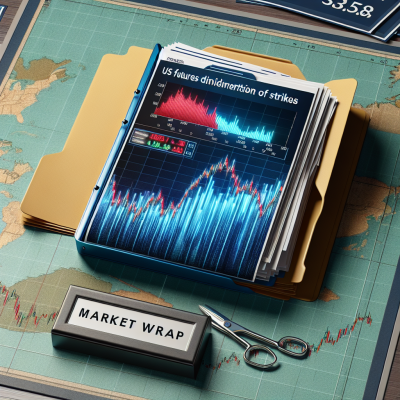
Market Volatility Returns Amid Rising US-Iran Tensions
US stock futures sank early Friday as geopolitical flashpoints intensified, with President Donald Trump reportedly weighing potential military support for Israel in its escalating confrontation with Iran. The markets responded swiftly and sharply to the news, with investors retreating from riskier assets in anticipation of wider regional instability in the Middle East.
Wall Street Rattled by Prospects of US Involvement
The major US indices, including the S&P 500 and Nasdaq 100 futures, indicated a weaker open in the wake of the report. Traders were caught off guard by the revelation that the Trump administration may be on the cusp of intervening militarily, raising fears of a broader, prolonged conflict.
Investors are keeping a close eye on how the geopolitical scenario may evolve in the coming days. Historically, markets have reacted sharply to uncertainty in the Middle East, especially when involving major global players like the US and Iran. Energy prices are particularly sensitive to such developments.
Iran-Israel Flareup Stokes Fear in Energy and Defense Sectors
While the full extent of the potential military escalation remains uncertain, the market reaction was swift and significant across multiple sectors:
- Energy stocks: Oil and gas companies saw gains pre-market as crude prices spiked due to fears of a disruption in supply chains through the Strait of Hormuz, a critical global oil artery.
- Defense contractors: Giants like Lockheed Martin and Raytheon saw heightened investor interest, with market participants betting on increased military spending amid escalating tensions.
- Tech and consumer sectors: These areas suffered the brunt of declines, as investors rotated out of growth assets and into traditional safe havens.
Crude Oil Surges as Strategic Chokepoint Faces Threat
News of rising US-Iran tensions drove crude oil futures higher by nearly 3% in pre-market trading. The potential for armed conflict threatens the secure flow of petroleum through the Middle East, which supplies more than one-fifth of the world’s daily oil consumption.
West Texas Intermediate and Brent Crude both jumped, signaling growing global concern about supply disruptions. If military involvement expands, analysts warn crude prices could skyrocket, potentially adding further pressure to global inflation levels.
Safe Havens in Demand: Gold and US Treasuries Rally
In classic risk-off fashion, gold prices moved higher, as investors sought shelter amidst growing geopolitical threats. Yields on US Treasuries also dipped, reflecting higher demand for perceived safe assets.
- 10-Year Treasury yields: Down several basis points, as buyers flooded the bond markets.
- Spot Gold: Edged to a multi-week high, reflecting investor anxiety.
Volatility Index Surges Amid Uncertainty
The CBOE Volatility Index (VIX), commonly known as Wall Street’s fear gauge, saw a sharp rise on Friday morning. The increase points to elevated investor nervousness and the possibility of larger price swings in the near term.
Strategic Calculations: Trump Administration Weighs Options
At the center of the market unease is President Trump’s contemplation of whether to provide direct military backing to Israel. While Trump has historically taken a hawkish stance on Iran, it’s unclear whether this will translate into immediate action.
Any decision to escalate or de-escalate US involvement will have profound effects on not only the geopolitical landscape but also on financial markets.
Investors, analysts, and political observers are closely watching Washington’s next moves, as the potential for war remains a sizable risk factor for global economic stability.
Global Reaction: A Wait-and-See Approach
International markets echoed the US reaction:
- European stocks: Opened modestly lower, with risk sentiment cautious across the board.
- Asian equities: Fell sharply, particularly in markets sensitive to energy imports and US foreign policy shifts.
Currency Markets Show Dollar Strength
The US dollar rose against major peers, aided by flight-to-safety flows. Meanwhile, emerging market currencies with high exposure to oil imports or US military presence experienced notable downturns.
Outlook: Investors Brace for More Uncertainty
As Friday unfolded, market watchers debated whether this is a temporary blip or the start of something much more serious. Volatility is likely to persist until greater clarity emerges from Washington and the Middle East.
Key Questions Facing Investors:
- Will President Trump commit US forces to a new confrontation in the Middle East?
- How will Iran and global oil producers respond?
- What is the Fed’s tolerance for inflation volatility tied to rising energy costs?
Strategic Moves for Turbulent Times
For investors, strategic diversification and staying attuned to geopolitical developments are paramount. Market participants are likely to make defensive plays in the near term, focusing on:
- Gold and precious metals
- Energy and defense equities
- Low-volatility utility and consumer staple stocks
Conclusion: Markets on Edge Awaiting White House Signals
The global investment community remains on tenterhooks as President Trump’s decision hangs in balance. While no official military action has been taken yet, the mere consideration has already set in motion waves across equities, commodities, and currencies alike.
In the days ahead, markets will likely respond to every headline and geopolitical development concerning the Iran-Israel conflict and the White House’s next steps. Investors should stay informed, vigilant, and prepared for heightened turbulence in the global financial system.
For now, uncertainty reigns—both on the battlefield and in the markets.


Leave a Reply